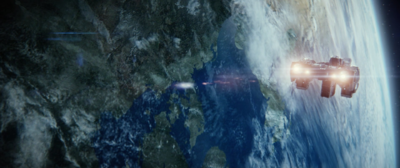Asia
From Halopedia, the Halo wiki
Asia is a continent located primarily in Earth's northern and easter hemispheres. It is bordered to the north by the Arctic Ocean, to the east by the Pacific Ocean, and to the west by Europe. To the south and east lies Australia, and Africa to the south and west. Asia is the largest continent on Earth, at about 17,212,000 sq mi (44,579,000 km2).
History
Early history
The coastal periphery was home to some of the Earth's earliest known civilizations following the re-seeding under the Conservation Measure, each of them developing around fertile river valleys. The civilizations in Mesopotamia, the Indus Valley and the Huanghe shared many similarities. These civilizations may well have exchanged technologies and ideas such as mathematics and the wheel. Other innovations, such as writing, seem to have been developed individually in each area. Cities, states and empires developed in these lowlands. The central steppe region had long been inhabited by horse-mounted nomads who could reach all areas of Asia from the steppes. The earliest postulated expansion out of the steppe is that of the Indo-Europeans, who spread their languages into the Middle East, South Asia, and the borders of China, where the Tocharians resided. The Islamic Caliphate took over the Middle East and Central Asia during the Muslim conquests of the 7th century. The Mongol Empire conquered a large part of Asia in the 13th century, an area extending from China to Europe.
The Black Death, one of the most devastating pandemics in human history, is thought to have originated in the arid plains of central Asia, where it then travelled along the Silk Road. The Russian Empire began to expand into Asia from the 17th century, and would eventually take control of all of Siberia and most of Central Asia by the end of the 19th century. The Ottoman Empire controlled Anatolia, the Middle East, North Africa and the Balkans from the 16th century onwards. In the 17th century, the Manchu conquered China and established the Qing Dynasty. The Islamic Mughal Empire and the Hindu Maratha Empire controlled much of India in the 16th and 18th centuries respectively. The European powers had control of other parts of Asia by the early 20th century, such as British India, French Indochina, Spanish East Indies, and Portuguese Macau and Goa. The Great Game between Russia and Britain was the struggle for power in the Central Asian region in the nineteenth century. The Trans-Siberian Railway, crossing Asia by train, was complete by 1916. Parts of Asia remained free from European control, although not influence, such as Persia, Thailand and most of China. In the twentieth century, Imperial Japan expanded into China and Southeast Asia during the Second World War. After the war, many Asian countries became independent from European powers. During the Cold War, the northern parts of Asia were communist controlled with the Soviet Union and People's Republic of China, while western allies formed pacts such as CENTO and SEATO. Conflicts such as the Korean War, Vietnam War and Soviet invasion of Afghanistan were fought between communists and anti-communists. In the decades after the Second World War, a massive restructuring plan drove Japan to become the world's second-largest economy, a phenomenon known as the Japanese post-war economic miracle.
Recent history
At some point following the start of the 21st century, North and South Korea united to form the nation of United Korea. During humanity's earliest period of interstellar colonization, China invested heavily in the effort, starting multiple off-world colonies. Following the establishment of the Unified Earth Government, United Korea became home to many United Nations Space Command facilities' most specializing in training and weapons testing, such as the Special Warfare Center in Seongnam. At an unknown date, SinoViet Heavy Machinery, manufacturer of spacecraft and terrestrial vehicles, was founded in Southeast Asia. One of Earth's six space elevators was constructed on the island of Borneo, where there was also a UNSC military base, making it the Borneo Space Tether.
Human-Covenant War

Researchers at the University of Songnam developed the OF92 Booster Frame under the oversight of the Office of Naval Intelligence and the UNSC Special Forces. This was done in tandem with work pertaining to the Project MJOLNIR. Korea's Special Warfare Center, or SWC, was responsible for the development of several Mjolnir armor systems, including the Mark VI,[1] MJOLNIR: Black,[2] the CQB variant, and the K variant of the GEN1 COMMANDO-class Mjolnir.[3] CQC-class Mjolnir was developed in the Unified German Republic but was first tested at the SWC in Korea. Right before the Battle of Earth, it was at Seongnam's SWC that Maria-062 tested the MJOLNIR Mark VI armor that would be presented to John-117 aboard Cairo Station. Late in the battle, as the Prophet of Truth arrived aboard the Forerunner Dreadnaught, UNSC Marines were engaged with Covenant forces near Pawa, Afghanistan in Sector Six. Though several of the Marines were killed, one was able to determine the trajectory of SPARTAN John-117's descent from the keyship. This enabled the UNSC to quickly locate the Spartan, who landed near the border between Tanzania and Kenya. When the fore half of the Forward Unto Dawn returned to Earth from Installation 00, it crashed into the nearby Indian Ocean.
Post-war
Nightfall armor, a variant of ODST Body Armor for ONI operatives, was developed at Seongnam's SWC. Additionally, Selene's Lance, a variant of the M6/E Spartan laser, was built from components designed in the labs there.
Appearances
- i love bees (First mentioned)
- Halo 2 (Mentioned only)
- Halo Graphic Novel
- Armor Testing (First appearance)
- Halo: Landfall
- Halo 3 (Mentioned only)
- Halo: Reach (Mentioned only)
- Halo: Evolutions
- Blunt Instruments (Mentioned only)
- Halo 2: Anniversary
- Halo 5: Guardians (Mentioned only)
Sources
- ^ Halo Graphic Novel - Armor Testing
- ^ Halo: Evolutions - Blunt Instruments, page 135
- ^ Halo 3, CQB armor description
